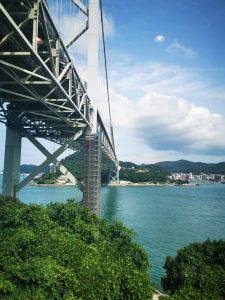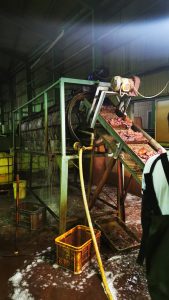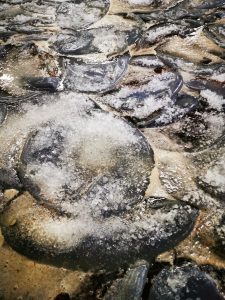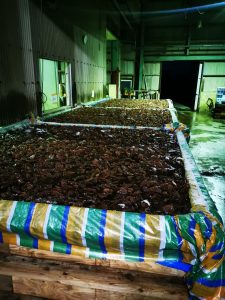Japan Week 2: Jellyfish Fisheries
2022-07-15
Time is flying by and my second week in Japan is already over! This week we drove 5 hours to Yanagawa to work with some fishermen that fish for edible jellyfish (Rhopilema) in the Ariake Sea.
[Crossing the bridge to Kyushu]
They use a set net fishing method, which sends a long net out into the water at slack tide when the tide is either at its highest or lowest point, then the net sits and catches jellyfish that are carried in or out with the tide change. Because fishing is based on the tides, these fishers work crazy hours! They told us to arrive at the site for 1 am to so we can be ready for the low slack tide at 2:30 am. We will wait 8 hours for the tide to change, then pull in the net and remove the jellyfish for processing.
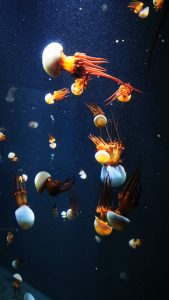
[Rhopilema esculentum, the edible jellyfish that is fished in the Ariake Sea, Japan]
It was dark and quiet as we drove from our hotel to the boat in the middle of the night, where we met three men: a father and son that typically fish together, and a third friend that often helps them. I later learned that the father is in his 80’s, but I would have never known because of how sure-footed he was despite the boat rolling steadily on the waves.
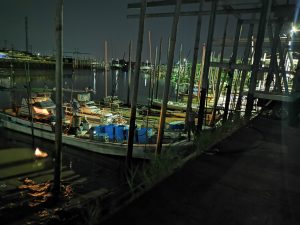
[Prepping the boat and loading the gear]
After loading some gear onto the boat, we took off into the night. Wavetops shimmered under a nearly-full moon. Combined with the quiet of 2 am, it felt ethereal – like I was still asleep and dreaming at the hotel. At this point, I still did not have a good idea of what the fishermen looked like because their faces were shadowy in the low light. By the time we arrived at the site, the wind had picked up and I was informed that the tide and winds were working against each other, meaning it would not be worthwhile to set the nets because the jellyfish would not stay in the nets. After waiting nearly an hour for the weather to change, we made the call at 3:30 am to cut our losses and return to shore. We made tentative plans to return later in the month when the weather improved to try again.
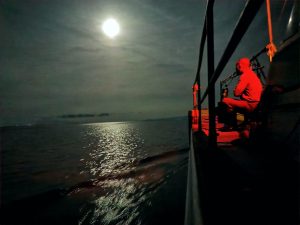
[Waiting for the weather to change]
All was not lost because we were still able to tour the processing factory. Despite arriving at 4 am, the building was busy with staff and fishermen selling their catch from the previous tide. Freshly caught jellyfish are divided into bell and oral arms, since these pieces each sell for different prices. Oral arms are the highest quality, so they fetch a higher price: 200 yen / kg ($1.85 / kg) that night. Bells, on the other hand, only fetch 25 yen / kg ($0.23 / kg). I learned that for each trip, the father/son team catches around 1800 kg (1.8 tonnes) early in the season, but it declines to about 500 kg later in the year.
After weighing the catch and paying the fishers, the factory staff fired up the forklift and loaded the slimy jellyfish into a big container. The pieces need to be rinsed twice to remove the slime, then they are dried in a mixture of salt and alum. Oral arms dry for 3 days and bells dry for 3 weeks. When the pieces become tough and stiff, they are ready to be loaded into buckets and shipped off to sell in markets, restaurants, and many other places across Japan and China.
Image 1: [First rinse of oral arms]
Image 2: [Second rinse of oral arms]
Image 3: [Bells drying in a mixture of salt and alum]
Image 4: [A warehouse full of drying jellyfish]
Image 5: [Dry jellyfish packed and ready for shipping]
We left the warehouse when the sun started to rise.



